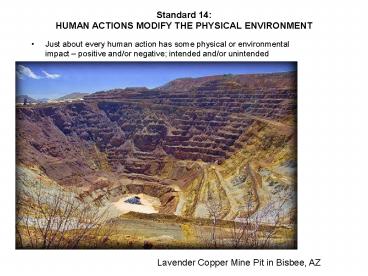Standard 14: HUMAN ACTIONS MODIFY THE PHYSICAL ENVIRONMENT - PowerPoint PPT Presentation
1 / 9
Title:
Standard 14: HUMAN ACTIONS MODIFY THE PHYSICAL ENVIRONMENT
Description:
Standard 14: HUMAN ACTIONS MODIFY THE PHYSICAL ENVIRONMENT Just about every human action has some physical or environmental impact positive and/or negative ... – PowerPoint PPT presentation
Number of Views:152
Avg rating:3.0/5.0
Title: Standard 14: HUMAN ACTIONS MODIFY THE PHYSICAL ENVIRONMENT
1
Standard 14HUMAN ACTIONS MODIFY THE PHYSICAL
ENVIRONMENT
- Just about every human action has some physical
or environmental impact positive and/or
negative intended and/or unintended
Lavender Copper Mine Pit in Bisbee, AZ
2
Society and Environment
Whether its mining an ore or cultivating
farmland or razing a desert to build a
sub-division or delaying legislation that would
lead to more stringent regulations on CO2
emissions or building a light rail for mass
transit humans actions and technologies have
had a great impact on the natural environment.
3
Human Actions Modify the Physical Environment
- There are consequences and costs, merits and
drawbacks, when the natural world is modified. - They might be political, societal (like health),
or economic reasons. For example, a mine may be
an important part of a towns or states revenue
while it is booming, like the Lavender Mine that
we saw in the first slide in this unit, but once
the ore is depleted, the economy falters. - What to do next to reinvigorate an old town? In
the case of Bisbee, Arizona, where the Lavender
Mine is located, the town became an artsy tourist
town, as seen below, and in 2005, the National
Trust for Historic Preservation named Bisbee one
of Americas Dozen Distinctive Destinations .
4
Human adaptation to and modification of physical
systems are influenced by the geographic context
in which people live, their understanding of that
context, and their technological ability and
inclination to modify the physical environment.
To survive people depend on the physical
environment. They adapt to it and modify it to
suit their changing needs for things such as
food, clothing, water, shelter, energy, and
recreational facilities. In meeting their needs,
they bring knowledge and technology to bear on
physical systems. Consequently, humans have
altered the balance of nature in ways that have
brought economic prosperity to some areas and
created environmental dilemmas and crises in
others.
5
Human Impact on the Environment
- Clearing land for settlement, mining,
agriculture provides homes and livelihoods for
some but alters physical systems transforms
human populations, wildlife, vegetation.
By-products, such as garbage, air water
pollution, hazardous waste, or overburden and
waste from strip mining are unavoidable. In
addition, they place enormous demands on the
capacity of physical systems to absorb
accommodate them. How much solid waste, toxic
waste, air and water pollution can Earths
ecosystems absorb before gasping their final
breath and collapsing?
6
Intended and Unintended Impacts on Physical
Systems
- Vary in scope and scale
- They can be
- Local and small-scale (e.g., like acid stream
pollution in eastern Pennsylvania), - Regional and medium-scale (e.g., an urban heat
island with its microclimatic effects in
Chicago), - Global and largescale (e.g., the clearing of the
forests of North America for agriculture or the
depletion of the ozone layer by
chlorofluorocarbons).
7
Human Impact on the Environment Implications on
Human Health Well-Being
Asthma, the most common chronic disease in
children and the primary cause of missed school
days, is responsible for more than 14 million
missed days per year. In 1980, that figure was
6.6 million days. Work absences due to asthma
attacks have increased as well, from 6.2 million
days in 1982 to 14 million days in 1999. If
current rates continue, the country will have 29
million people with asthma by the year 2020.
Source The Department of Health and Human
Services in a report by http//www.ncsl.org/defau
lt.aspx?tabid13185
8
Standard 9 Wrap-Up
- Understanding global interdependence begins with
an understanding of global dependence-the
modification of Earths surface to meet human
needs. - When successful, the relationship between people
and the physical environment is adaptive when
the modifications are excessive the relationship
is maladaptive. - Increasingly, students will be required to make
decisions about relationships between human needs
and the physical environment. - They will need to be able to understand the
opportunities and limitations presented by
geographical contexts and to set those contexts
within the local to global continuum.
9
By Elizabeth Larson, PhDLecturer, School of
Geographical Sciences and Urban Planning, Arizona
State University, 2011































